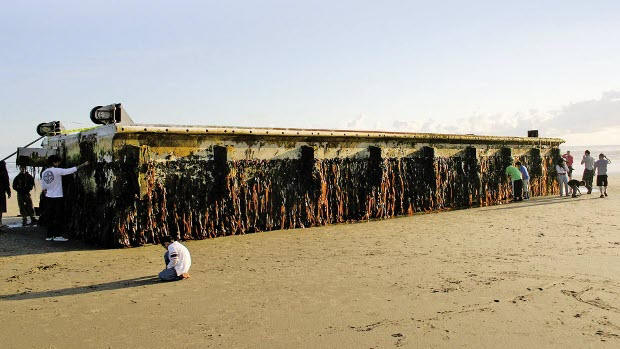Tsunami of debris just the beginning
Researchers say waste may keep washing ashore in U.S. for decades
- June 29, 2012
- By Jeremy Carroll

A boy kneels before a 66-foot-long dock that washed into the Pacific Ocean during the 2011 tsunami in Japan. It floated across the ocean and turned up earlier this month at Agate Beach State Park in Oregon. The dock is scheduled to be dismantled and landfilled. Officials along the West Coast and in Hawaii say debris large and small is likely to continue washing ashore in the U.S. for years, perhaps for decades. The dock has become an unexpected tourist attraction.
When a massive dock washed ashore in Oregon earlier this month, Chris Havel immediately thought that it might have been from Japan.
Havel, spokesperson for the Oregon Parks and Recreation Department, said the department went to work right away to determine its origin, confirming with the Japanese embassy within 24 hours that the dock was indeed lost in the tsunami on March 11, 2011.
Measuring 7 feet tall, 19 feet wide and 66 feet long, the dock, made out of concrete and metal, apparently made the more than 6,500 mile trek from Minamisoma, Japan, to Newport, Ore., in just more than a year, beating the time parameter researchers had laid out on debris reaching the West Coast of the United States.
Light debris, like plastic, Styrofoam and, perhaps, some fishing nets were supposed to reach the coast later this summer, but big items weren't expected until 2013 at the earliest. Now, officials up and down the West Coast and in Hawaii are pondering the best way to handle the tsunami of debris headed their way.
"You can collect debris in any number of ways, but how do you dispose of it?" Havel asked. "Putting your hands on it is the beginning of the tale and finding a final resting place for it, whether it's reuse, recycling or landfill, is the other question. There is no single budget capable of handling what is predicted to be the volume over the two-year period."
Anticipating some cost in tsunami debris cleanup, Oregon boosted its two-year coastal cleanup budget from $85,000 to $135,000, but Havel said it's obvious that will not be adequate.
As big as it is, the dock is only a small fraction of the estimated 4 million to 8 million tons of debris that was washed into the Pacific Ocean following the tsunami. The vast majority of that material will never reach land, said a researcher with the International Pacific Research Center, based in Hawaii.
"Estimates from our model suggest that at least 95% of the debris that has not sunk will move into the North Pacific garbage patch," said Nikolai Maximenko, a senior scientist with group, in a statement, "where it may stay for years, break up into smaller pieces, and mix with old marine debris that has accumulated there over the years."
That's why Hawaii – on the southern edge of prevailing ocean currents – is at particular risk. The islands could be attracting debris for decades.
"Effects [from the] tsunami debris ... [in] Hawaii will continue for many years," he said.
Somewhere in the neighborhood of 1 million to 2 million tons of debris is still floating in the ocean. Maximenko said there is no way of knowing how different types of debris will behave.
Maximenko said the group is working to update its models to show the actual movement of materials.
"The debris that is still floating is widely dispersed across the north Pacific Ocean," he said.
Back in Oregon, officials asked locals for bids to landfill the dock, reuse it or recycle it. Bids ranged from $80,000 for landfilling to $115,000 for reuse. Oregon chose to accept the low bid.
"Everybody wants to [reuse it], but it's a matter of expense," Havel said. "Right now, this is coming out of our budget and obviously when we did our budget we didn't [anticipate this]."
The Oregon Parks and Recreation Department will be meeting with the Oregon Refuse and Recycling Network to hammer out disposal plans for other items, but money is tight, he said.
"The government has to step up and say, 'You coastal communities, you cannot bear this burden alone. This is not just your problem,' " Havel said.
In neighboring Washington, Gov. Christine Gregoire announced at a recent press conference that the state's Military Department Emergency Management Division would take the lead on tsunami debris cleanup efforts. But she's hoping the money comes from elsewhere.
"The federal government is the ultimate lead, as our state responds to tsunami debris that washes up on our beaches, but our federal partners need support to protect our coast and keep our citizens safe," she said.
Copyright © 1995-2012 Crain Communications Inc. All Rights Reserved. http://www.wasterecyclingnews.com